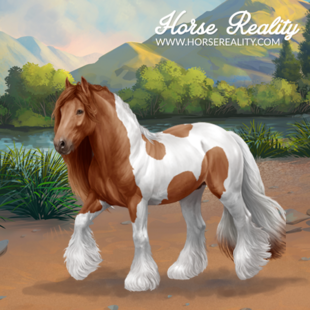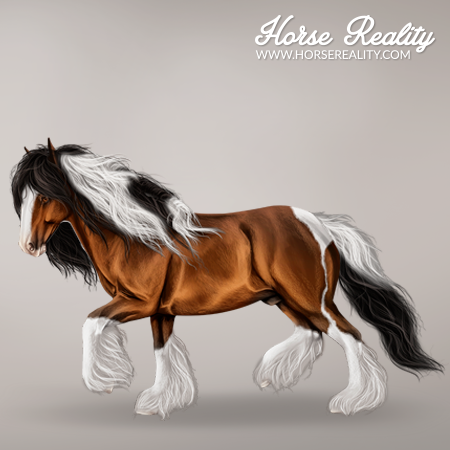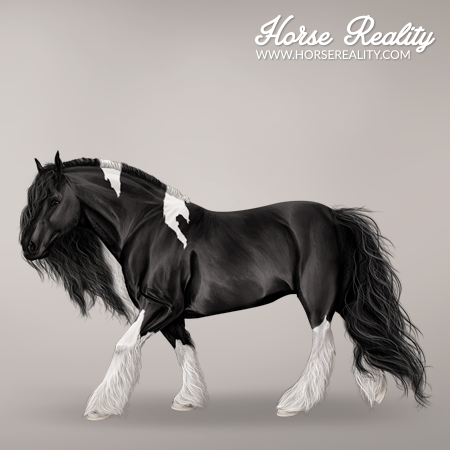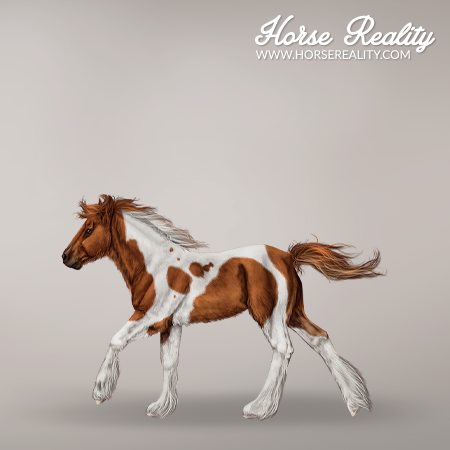The Irish Cob Horse is a breed available in the Horse Reality game that can be obtained from the Foundation.
| Irish Cob Horse | |
|---|---|

|
|
| General Information | |
| Alternative names | Gypsy Vanner*, Tinker |
| Origin | United Kingdom |
| Horse Reality | |
| Colours | Black, Chestnut, Bay, Seal Brown, Flaxen, Pangaré, Sooty, Grey, Cream, Pearl, Silver, Dun |
| Whites | White Markings, Appaloosa, PATN1, PATN2, SW1, Tobiano, Sabino-1, Roan |
| Not yet in-game | W20, Snowdrop |
| Height | 135 - 170 cm |
| Registry | Irish Cob Society |
| Alternative name | IC |
| Origin | Foundation |
| Status | In-game (2018) |
| Artists | |
| Lineart | D. Grochowska (2020) |
| Greyscale | D. Grochowska (2020) |
| Colours & patterns | D. Grochowska, H. Vasseur, A. van Rooijen (2020) |
¶ History
The Irish Cob was developed by the travelling communities of Great Britain from around 1850. They needed horses that were sturdy enough to pull their caravans, called vardos, but also gentle-natured to be among their children. The result was a versatile and strong horse. The horses were often colourful. These had become undesirable to society at the time, and ended up with the travelling breeders after being culled. The Irish cob was refined in the years following the Second World War; before this, it was more considered a type, rather than a breed, with some variation in its characteristics. It was shaped by breeds such as the Shire, Clydesdale, and Dales Pony. At first, lineages were passed down verbally for many generations. The studbook was officially founded in 1998.[1,2]
¶ Characteristics
The Irish Cob Horse is a light draft breed. The breed has a “sweet” head, set on a strong, arched neck. The chest is deep, broad and well-muscled. The withers are rounded and not very visible. They have a short, wide back and muscular hindquarters with a rounded croup. The hind legs are angled for pulling and tend to be set outwards. Feathering, long hairs on the lower legs covering the hooves, is a typical characteristic of the breed. Mane and tail are also often long and thick. Some horses even sport a luxurious moustache. The desired height range varies between breed societies, and some studbooks have different categories based on height and/or refinement.[2-5]
The gaits are powerful, sometimes with higher knee action. The Irish Cob is a kind and intelligent horse, eager to please, confident and social in nature. Its strength and temperament make the breed a versatile horse for riding and driving.[2]
¶ Colour Genetics
The Irish Cob is a very colourful breed; any colours and white patterns are allowed. The breed can have any base colour, but black is the most common. Dilutions are uncommon and include cream, silver, more rarely dun and even pearl. Flaxen, sooty and pangare can modify the different colours. Grey is rare as it hides their beautiful colours.[2,3]
The Irish Cob is well known for its wide range of patterns. Tobiano is very common, but sabino-1 and roan are also present. Many horses appear to display splash or sabino-like patterns, referred to as "blagdon". W20 has been found in a few horses, where it enhances the horses' patterns. Leopard complex patterns also appear in the breed.[2,3,5]
¶ In-game colours
All alleles available for the breed can be found below, highlighted in green. For better clarity, we bolded alleles that impact coat colours (eg. grey G vs non-grey g).
| Base Colours & Modifiers | ||
|---|---|---|
| Extension | Agouti | Grey |
| E, e | A, At, a | G, g |
| Dilutions | ||||
|---|---|---|---|---|
| Cream-Pearl | Dun | Champagne | Silver | Mushroom |
| CR, prl, n | D, nd2 | ch | Z, z | n |
| White Patterns | |||||
|---|---|---|---|---|---|
| Frame | Appaloosa | PATN1 | MITF | SW2 | KIT |
| n | LP, lp | PATN1, patn1 | SW1, n | sw2 | TO, RN, SB1, n |
Please note that the table includes a hidden agouti allele (At). Besides testable genes, there are also untestable ones present: flaxen, pangaré, sooty, PATN2 and white markings (head markings, socks, etc.).
¶ Uses
The Irish Cob is a trustworthy horse for the whole family. In the past, the breed was primarily used for pulling wagons, but now it is used in all disciplines. The breed is popular as a dressage, western riding, driving, trail riding or therapy horse.[5]
¶ Artwork Changelog
The Irish Cob Horse has been in-game since 2015, when it was released under the name “Gypsy Horse”. Ever since the current Horse Reality version has been online, the Irish Cob Horse has received/will receive the following updates:
- On December 16th 2020, the breed was reintroduced with new artwork and the name was changed to "Irish Cob Horse"[6]
- On October 16th 2025, the Irish Cob was migrated to the new art system and the sooty, pangaré, grey, splashed white 1, and leopard complex genes were added[8-10]
- The missing genes and alleles will be added to the game through Foundation horses[11]
¶ About the Name Change
*Alongside the artwork update, a name change followed. The name “Gypsy Horse” has created much controversy among players. The word ”Gypsy” is a racial slur commonly used to describe the Romani people. It has been used throughout centuries of oppression and continues to be associated with ethnic tensions in today’s world. Due to the origin of such words, they can negatively impact a community even when used innocently, for example, in the name of a horse. The term is therefore prohibited on all Horse Reality platforms and is used here for educational purposes only.[6,7]
¶ Artwork Legacy
If you're curious about what the Irish Cob Horse looked like before the artwork update or just want to reminisce about good old times - search no more.

|

|

|
This beautiful art was created by very talented artists. Horse Reality is forever grateful for them being a part of its history.
| Artists | |
|---|---|
| Lineart | A. Brost (2014) |
| Greyscale | A. Brost (2014) |
| Colours & patterns | T. van den Berg (2014) |
¶ References
- Irish Native Rare Breed Society, Irish Cob: https://inrbs.ie/irish-cob/; Access: September 2025
- Irish Rare Breed Society: https://irbs.ie/traditional-irish-breeds/irish-cob/; Access: September 2025
- Irish Cob Society Netherlands: https://ics-nederland.com/en/breed-standard/; Access: September 2025
- Australasian Gypsy Horse Society Inc., Breed Standard: https://www.gypsyhorsesociety.com.au/facility; Access: September 2025
- Gypse Vanner Horse Society: https://vanners.org/breed-standard/; Access: September 2025
- https://v2.horsereality.com/news/45/community-update-christmas-surprise-remake-of-the-irish-cob-gypsy-horse
- https://v2.horsereality.com/news/87/community-update-rule-enforcement-update-forgiving-discord-offences-npc-writing-contest-exmoor-pony-making-of-user-survey
- https://v2.horsereality.com/news/249/announcement-horse-realitys-7th-birthday
- https://v2.horsereality.com/news/250/announcement-irish-cob-migration-on-october-14-hrs-birthday-week
- https://v2.horsereality.com/news/251/release-notes-irish-cob-migration-coat-hunt-event-imgbb-images-more
- https://deloryan.notion.site/Horse-Breeds-Artwork-Genetics-6d0a84be35284b12806976bbb8cc886c